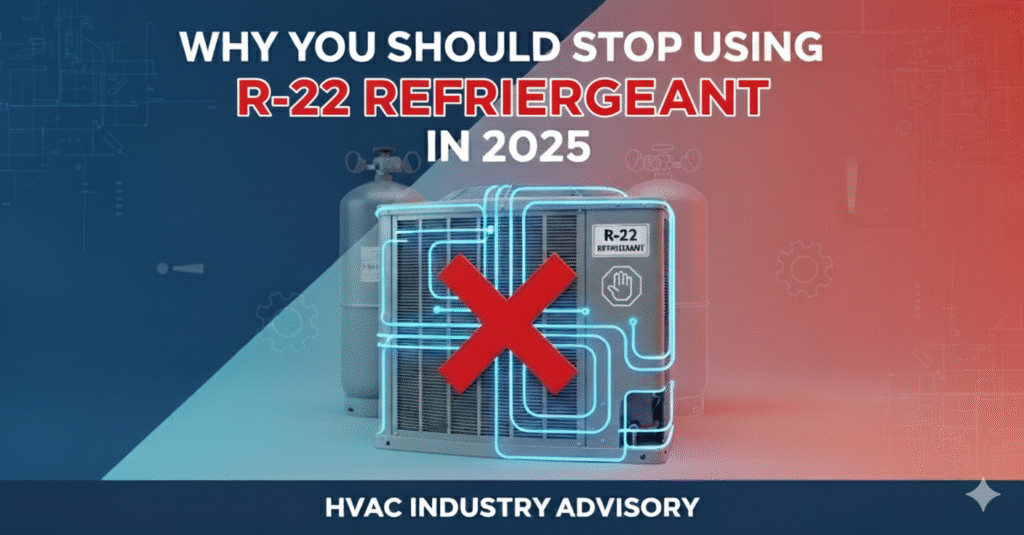Introduction
For decades, R-22 refrigerant (commonly known as Freon) was the go-to cooling agent in air conditioners and refrigerators. Homeowners trusted it for reliable comfort — but times have changed. As of 2025, R-22 is not just outdated; it’s banned, harmful to the environment, and extremely expensive to source.
If your system still relies on R-22, you’re facing higher maintenance costs, declining efficiency, and serious environmental risks. This guide explains why you should refuse R-22, what alternatives are available, and the smartest steps for homeowners in Canada.
1. What is R-22 (Freon) and Why Was it Popular?
R-22, often referred to as “Freon,” is a hydrochlorofluorocarbon (HCFC) refrigerant. It was widely used in residential and commercial air conditioning systems built before 2010.
Why was it popular?
- Effective cooling – provided reliable temperature control.
- Widely available – was the industry standard for decades.
- Affordable (in the past) – inexpensive compared to alternatives at the time.
However, what was once considered efficient is now recognized as a major environmental threat.
2. Why R-22 is Dangerous & Phased Out
The phase-out of R-22 wasn’t random — it was a global response to environmental and health concerns.
Key reasons:
- Ozone Depletion: R-22 contains chlorine, which damages the ozone layer. A thinner ozone layer means increased UV radiation, leading to higher risks of skin cancer, cataracts, and ecosystem damage.
- Toxicity Risks: R-22 can be harmful when leaked or improperly handled, posing risks to both technicians and homeowners.
- Greenhouse Gas Effect: R-22 has a high global warming potential (GWP), worsening climate change.
In short: every pound of R-22 released has lasting negative effects on the planet and public health.
3. The R-22 Phase-Out Timeline in Canada (Updated 2025)
Canada followed the international Montreal Protocol, which mandated the gradual elimination of ozone-depleting refrigerants.
- 2010: Production of R-22-based equipment stopped.
- 2020: Import and production of R-22 for servicing existing equipment was banned.
- 2025: R-22 is nearly impossible to source, with only recycled or stockpiled refrigerant available — at extremely high prices.
Today, homeowners relying on R-22 are paying hundreds (sometimes thousands) of dollars for simple recharges, making old systems financially unsustainable.
4. Why You Should Refuse R-22
Even if your system still runs on R-22, here’s why it’s smart to let it go:
- Health Risks: Leaks can expose you to harmful gases.
- System Inefficiency: R-22 systems are outdated, consuming more electricity compared to modern units.
- Skyrocketing Costs: With limited supply, R-22 refills are extremely expensive.
- No Long-Term Support: HVAC companies are shifting away from servicing R-22, resulting in fewer repair options.
Sticking with R-22 is like driving a car that needs leaded gasoline — outdated, costly, and unsafe.
5. Safe & Efficient Alternatives to R-22
Thankfully, modern refrigerants are eco-friendly, efficient, and future-proof.
Common alternatives:
- R-410A: The most widely used replacement, offering better efficiency and cooling capacity.
- R-32: More environmentally friendly with lower GWP than R-410A.
- R-454B & Other Blends: Next-generation refrigerants designed to meet stricter environmental standards.
⚠️ Note: R-410A itself is scheduled for gradual phase-out in the coming years, so systems using R-32 or R-454B are more future-ready.
6. What to Do if Your System Still Uses R-22
If your AC or HVAC system still runs on R-22, you have three main options:
1. Retrofit Your System
Some older units can be retrofitted to use modern refrigerants. However, this isn’t always possible and can be expensive.
2. Replace with a New System
The most cost-effective long-term solution is to upgrade to a new energy-efficient system. While the upfront cost may seem high, the savings in energy bills and repair costs will quickly pay off.
3. Short-Term Maintenance
If replacement isn’t possible right now, ensure proper maintenance to reduce leaks and keep the system running safely. But this is only a temporary solution.
Conclusion
R-22 refrigerant had its time — but in 2025, continuing to rely on it is bad for your wallet, your health, and the environment. With skyrocketing costs, limited availability, and harmful impacts, refusing R-22 is the smartest choice for Canadian homeowners.
Instead, explore modern, efficient, and eco-friendly alternatives like R-32 and R-454B. Not only will you protect the environment, but you’ll also enjoy better comfort, lower bills, and peace of mind.
Ready to replace your old R-22 system? Contact GM Heating and Cooling Inc. today for expert advice and installation of energy-efficient solutions.
FAQS
Q1: What is R-22 refrigerant?
A: R-22, also known as Freon, is a hydrochlorofluorocarbon (HCFC) used in older air conditioners and heat pumps. It’s being phased out due to environmental concerns.
Q2: Why is R-22 refrigerant being phased out?
A: R-22 contributes to ozone layer depletion and has high global warming potential. Regulatory agencies have mandated its phase-out to protect the environment.
Q3: Can I still use R-22 in my AC system?
A: Existing systems can use R-22 temporarily, but production has largely stopped. It’s expensive and less environmentally friendly, so replacing your system or switching to alternative refrigerants is recommended.
Q4: What are the risks of continuing to use R-22?
A: Continuing to use R-22 can lead to higher repair costs, difficulty finding the refrigerant, reduced efficiency, and negative environmental impact.
Q5: What are the alternatives to R-22 refrigerant?
A: Common alternatives include R-410A and R-407C, which are more eco-friendly and widely available in modern AC systems.
Q6: How do I know if my system uses R-22?
A: Check the AC unit label or manual. Older systems, especially pre-2010 models, typically use R-22. A licensed HVAC technician can confirm.


